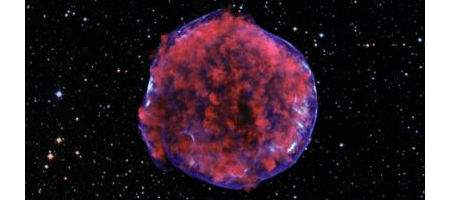Move over CERN: a pattern of X-ray ‘stripes’ in the remains of a supernova may provide the first direct evidence that supernovae can accelerate particles to energies a hundred times higher than the Large Ladron Collider.

The discovery comes from observations of the Tycho supernova remnant with NASA’s Chandra X-ray Observatory – and could explain how cosmic rays are produced.
“We’ve seen lots of intriguing structures in supernova remnants, but we’ve never seen stripes before,” said Kristoffer Eriksen, a postdoctoral researcher at Rutgers University who led the study.
“This made us think very hard about what’s happening in the blast wave of this powerful explosion.”
The team believes that magnetic fields become highly tangled, and the motions of the particles very turbulent, near the front edge of the expanding supernova shock wave. High-energy charged particles can bounce back and forth across the shock wave repeatedly, gaining energy with each crossing.
Theoretical models of the motion of the most energetic particles – which are mostly protons – are predicted to leave a messy network of holes and dense walls corresponding to weak and strong regions of magnetic fields, respectively.
The X-ray stripes discovered by the Chandra researchers are thought to be regions where the turbulence is greater and the magnetic fields more tangled than surrounding areas, and may be the walls predicted by the theory. Electrons become trapped in these regions and emit X-rays as they spiral around the magnetic field lines.
However, the regular and almost periodic pattern of the X-ray stripes was not predicted by the theory.
“It was a big surprise to find such a neatly arranged set of stripes,” said co-author Jack Hughes, professor of physics and astronomy at Rutgers. “We were not expecting so much order to appear in so much chaos. It could mean that the theory is incomplete, or that there’s something else we don’t understand.”
Supernova remnants have long been considered a good candidate for producing the most energetic cosmic rays in our Galaxy. The protons can reach energies that are hundreds of times higher than the highest energy electrons, but since they don’t radiate efficiently like the electrons, there’s been no direct evidence until now for the acceleration of cosmic ray protons in supernova remnants.






